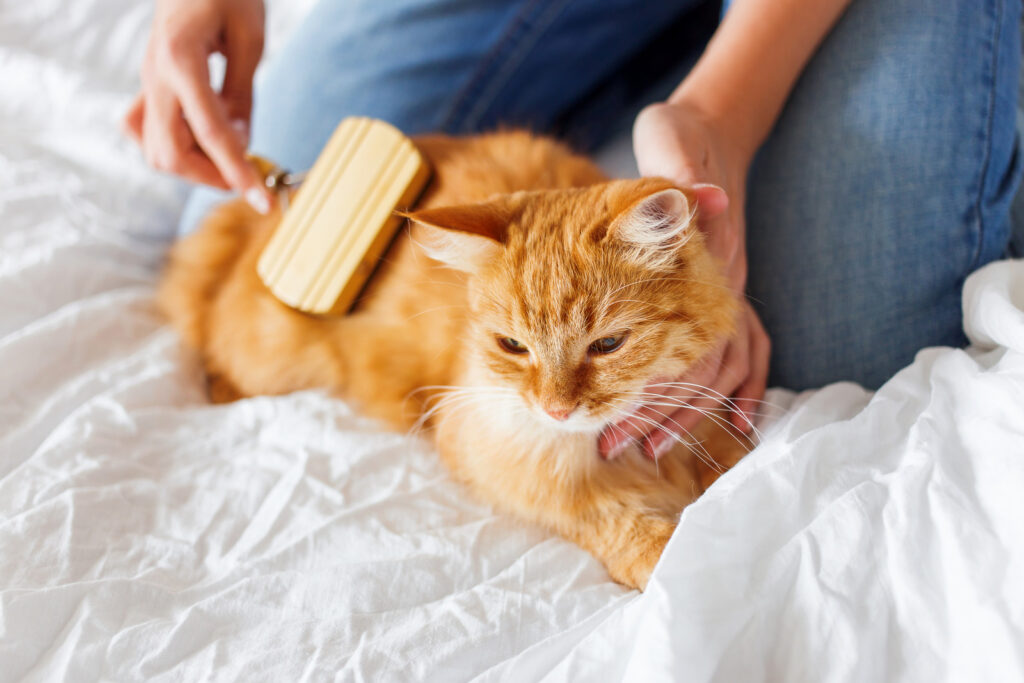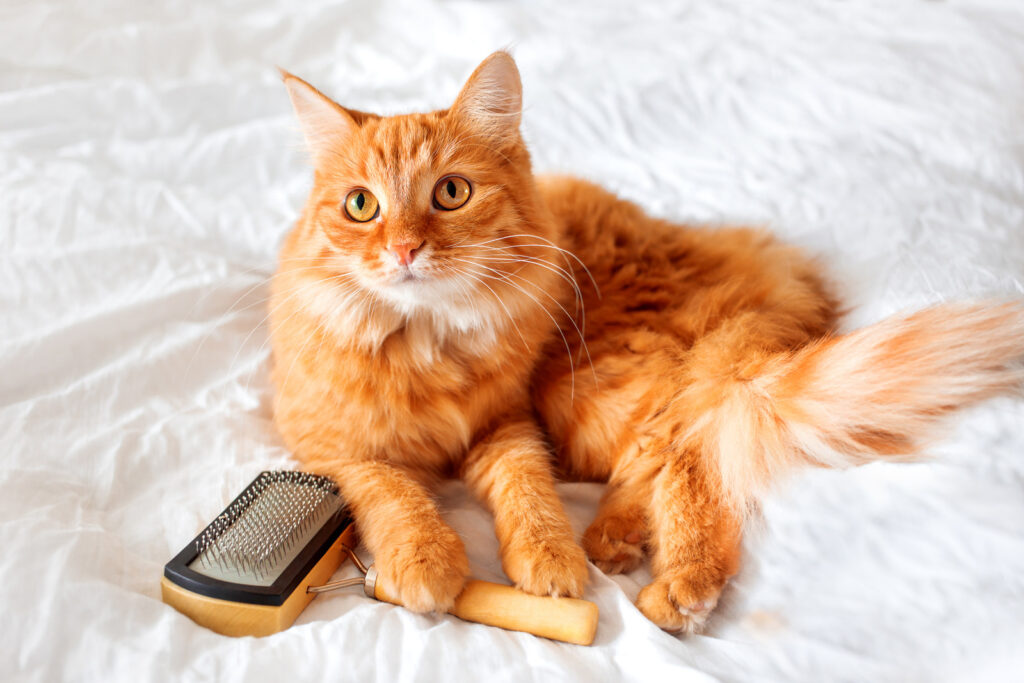While cats don’t tend to be clipped, unlike dogs and hoomins, they do have special grooming needs, particularly for breeds with long hair. Cat fur has a tendency to get clumped together in knots and these can become painful if left, pulling on your pet’s skin as they walk. Read on for our top tips on how to groom your cat.
Why do cats need grooming?
Cats are well-known for being relatively clean animals and will take care of some of their grooming needs themselves. Their tongues even have teeny little barbs to help groom their coats as they lick – this is why they can feel so rough when they decide to turn their attention to licking their human family members!
Cats with longer fur, or older pets that are finding grooming trickier, will need regular brushing to keep their fur in good condition and prevent knots. However, even short-haired felines can benefit from a bit of pet-owner bonding, plus this is a great opportunity to check your pet for any lumps, bumps or injuries. If you are wondering how often to brush a cat, it is often best to make grooming a daily activity to help stop stubborn matts from forming.
How to groom your cat
Try to introduce grooming as a positive experience when your pet is feeling relaxed, reward them with treats and gradually increase the length of grooming time over a period of a few weeks. Most cats like to be stroked around their head area, but hate having their bellies touched. Therefore, groom your cat on their head and back to begin with, and then progress to other areas as they become more comfortable. Keep an eye on your pet and do not risk getting nipped if they are starting to show signs of getting grumpy.
There are plenty of cat combs and brushes and you can choose between these depending on your preference. A comb might be more suitable to groom cats with finer fur though, and brushes can help for those with thicker and longer coats.
Clipping your cat is generally not advised unless there are severe knots that cannot be removed by brushing. Never use scissors on your cat, as it is difficult to ensure you don’t accidentally catch their skin beneath all that hair. They can have surprisingly saggy regions of skin, particularly around their belly and armpits, and it is not worth the risk of causing an injury or making grooming a negative experience for you both. If you do decide to clip an area of your cat’s fur, it is best to use pet-safe clippers and get your cat gradually used to the noise. Check the blade regularly in case it has become too hot, and be sure to hold the blade parallel to your pet’s skin to help reduce the risk of causing a rash.
Cat claws can also need attention. While most adult cats will wear these down naturally, the claws of some individuals can become overgrown and dig into their pads, which is very sore and can lead to infection. Older cats are more likely to have these issues as their claws are often thicker and they wear them down less as they become less active. Always use specialised cat claw clippers, and do not attempt this without a demonstration first from a vet or vet nurse. They will show you how to avoid cutting the quicks of your cat’s claws, and how to stop a bleed if this occurs. Most veterinary clinics offer claw clipping appointments, and many owners opt to book in for these rather than going DIY.

How often to bathe a cat
Giving your cat a bath is not usually recommended unless it has been advised by your vet as part of a medical treatment plan. Most cats do not enjoy having a bath, and it can cause a lot of stress, as well as stripping the natural oils from their skin and fur. If you do need to give them a wash for any reason, stick to pet-safe products. Human shampoos are not suitable for use in cats, as their skin pH is different, and ingredients used in human products are not safe to be licked by our four-legged friends when they self-groom.
Cat fur loss
Fur loss can have a huge range of causes: fleas and other parasites, skin allergies, fungal infections, hormonal conditions, or over-grooming. Cat hairloss on ears can be one of the first places to spot fur loss, but it can occur anywhere on the body. It is best to speak to a vet for advice, particularly as some causes of hairloss, such as certain fungal infections, can be passed on to humans.
Cat grooming behaviours
Is your cat grooming excessively? This is a fairly common problem reported by pet owners and can suggest a behavioural or medical issue. The main behavioural cause of over-grooming is stress, and bouts will often be triggered by changes to your cat’s environment. Medical causes include pain from conditions such as arthritis, or other neurological and orthopaedic problems. However, over-grooming can also be caused by intense irritation or pain due to parasites or skin infections. If you notice your cat is grooming too much, it’s best to check whether they’re up to date with their flea treatment.

What do cat hairballs look like?
Cat hairball vomit is generally a cylinder of fur (rather than a ball) coated in slimy mucous – yuck… It can often seem like your cat is coughing up furball, but these actually are brought up from the stomach through the oesophagus. Cat furball symptoms mainly include seeing your cat retching, and bringing up the offending furball. Or you might just find these unsavoury offerings around the house or garden. Regular grooming can help to reduce the occurrence of furballs, and if it is just the occasional issue then this is unlikely to be a cause for concern. However, if your cat is regularly bringing up hair balls, or it is occurring with increasing frequency, it may be best to seek veterinary advice.
Can you brush cat teeth?
Yes, you can – although not all cats will tolerate this, and it is best started from a young age with plenty of positive reinforcement through treats. You should never use human toothpaste as this can contain sweeteners or other ingredients that are toxic to cats. A cat toothbrush and toothpaste is best. Do not persist if your cat is showing signs of getting angry. Cats can have particularly unpleasant bacteria on their teeth so you could pick up a nasty infection if they nip your finger.
How to choose a groomer
Search for ‘Cat grooming near me’ online and chances are you will get a lot of hits. If you are looking for an extreme groom for your cat, it might be best to speak to your vet first as a sedation may be necessary to help get back on top of your cat’s knotted fur. Otherwise, be sure to check with a groomer whether they have any tips for making the experience less stressful for your feline. For example, do they offer an ‘at-home’ service where they groom your pet in their own environment? Or do they have protocols in place to help keep cats away from any dogs visiting the salon?
Allergic to cat hair
If you have cat allergies, there are a few things that can help, although you should also follow any advice given by your medical practitioner. The main cat allergen that people react to is actually in their saliva. However, because they lick their fur, this allergen also ends up on cat hair and this is one of the main ways that people are exposed to it. You can groom your cat outside to help reduce fur shedding in your house. There are also cat foods available that reduce the levels of the allergen in their saliva, and this can help reduce your exposure.
Love your pets? So do we! Join in the conversation over on our Facebook page.


